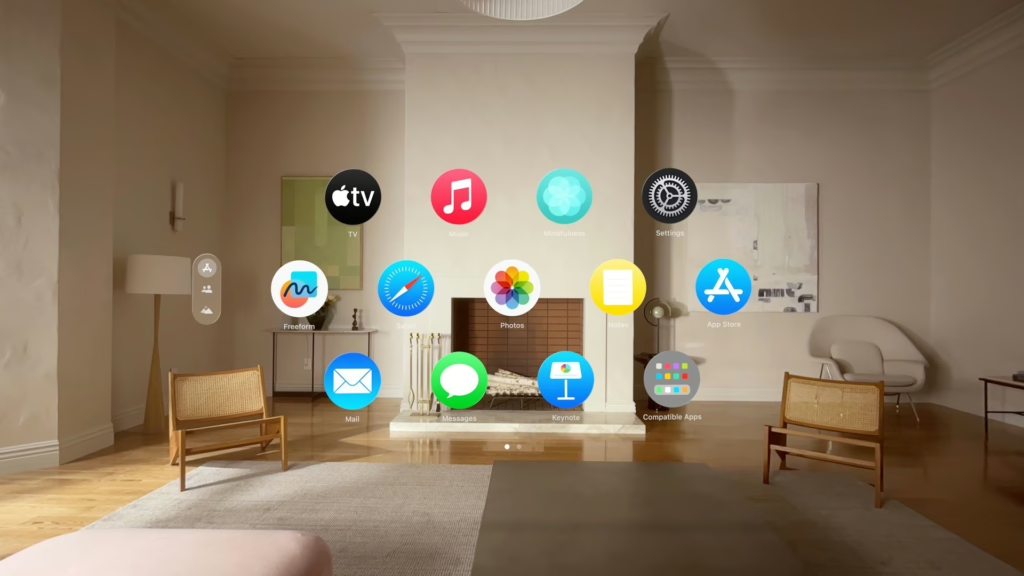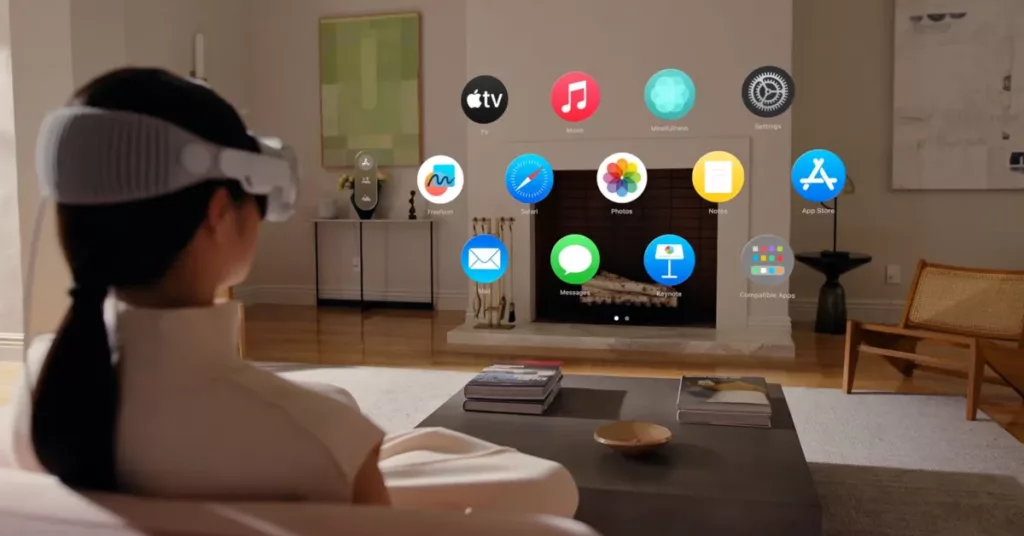Apple’s VisionOS, the operating system powering the Vision Pro headset, is paving the way for a new era of augmented reality (AR) and mixed reality (MR) experiences.
Launched in February 2024, the Vision Pro has quickly gained traction, with VisionOS 2 already promising significant improvements. As Tim Cook predicted, AR is poised to become an essential tool in our daily lives, enhancing creativity and collaboration. The success of iOS 17, which includes VisionOS, suggests a growing user base eager to embrace these innovative technologies.
In this guide, we’ll explore the exciting world of VisionOS app development. We’ll delve into the benefits for businesses, uncover key features, and provide insights into the development process.

Table of Contents
What is VisionOS App Development?
VisionOS technology is a revolutionary operating system designed to power augmented reality (AR) and mixed reality (MR) devices. By seamlessly blending digital content with the real world, VisionOS offers developers a unique platform to create immersive and engaging experiences.
Key features that make VisionOS app development a captivating endeavor include:
- Spatial Mapping: VisionOS accurately scans and understands your physical environment, creating a digital map that serves as the foundation for AR interactions.
- Gesture Recognition: Intuitive hand gestures replace traditional buttons, allowing users to interact with digital content seamlessly.
- 3D Object Tracking: VisionOS can recognize and track real-world objects, enabling developers to create AR experiences that seamlessly integrate with the physical environment.
- Scene Understanding: VisionOS comprehends the context of its surroundings, ensuring that digital content is placed and behaves appropriately within the real-world scene.
Benefits of VisionOS App Development for Businesses
Apple’s Vision Pro, powered by VisionOS technology, has rapidly become a focal point, with over 2,500 spatial apps designed specifically for the device. This growing ecosystem offers businesses a wealth of opportunities to enhance customer engagement, gain a competitive edge, and boost revenue.
Key benefits of VisionOS app development for businesses include:
- Enhanced Customer Engagement: Create immersive experiences that resonate with customers and drive sales. For example, a retail app could allow users to virtually try on clothes or visualize furniture in their homes.
- Competitive Advantage: Be a pioneer in the AR space and differentiate your business from competitors. Offer unique AR experiences that captivate and delight customers.
- Increased Revenue: Generate new revenue streams by offering innovative AR-powered services or products. Real estate agencies can showcase properties in 3D, while educational institutions can create interactive learning experiences.
- Improved Customer Service: Provide exceptional support with AR-powered troubleshooting guides and tutorials. Reduce customer frustration and increase satisfaction.
- Boosted Brand Recognition: Create memorable and engaging experiences that solidify your brand identity and build stronger connections with customers.
- Enhanced Efficiency and Productivity: Streamline workflows and reduce errors by providing workers with real-time information and guidance in industrial settings.
By embracing VisionOS app development, businesses can unlock a world of possibilities and gain a significant competitive advantage in the digital age.
Key Features of VisionOS App Development
VisionOS, Apple’s groundbreaking platform for augmented reality (AR) and mixed reality (MR), offers developers a unique set of tools to create immersive and interactive experiences. With its four core features specifically for VisionOS app development, VisionOS empowers app creators to build innovative applications that push the boundaries of what’s possible.
Spatial Mapping
VisionOS empowers apps to understand the physical world and anchor digital content precisely. By scanning your surroundings, VisionOS creates a detailed digital map that serves as the foundation for AR experiences.
- How it works: VisionOS identifies surfaces, objects, and landmarks, providing a comprehensive understanding of your environment. This allows virtual objects to be placed and anchored accurately, creating a seamless integration with the real world.
Gesture Recognition
VisionOS simplifies interaction by recognizing and responding to natural hand gestures. This intuitive approach makes AR experiences feel more natural and engaging.
- How it works: By using gestures like swiping, pinching, and waving, users can effortlessly control digital content within the AR environment. This eliminates the need for complex controls or voice commands, providing a more intuitive and enjoyable experience.
3D Object Tracking
VisionOS transforms your environment into a dynamic canvas where virtual objects can coexist and interact with the real world.
- How it works: VisionOS accurately recognizes and tracks 3D objects, ensuring that they remain anchored in place as you move your head or device. This creates a sense of permanence and realism, making AR experiences feel more immersive.
Scene Understanding
VisionOS goes beyond object recognition by comprehending the context of the surrounding environment. This enables apps to provide more relevant and engaging experiences.
- How it works: Scene understanding allows apps to respond contextually by analyzing the user’s surroundings and providing tailored information or actions. For example, an AR travel guide might offer historical tidbits when pointed at ancient ruins.
Step-by-Step Guide to VisionOS App Development Process
Start developing your Apple’s VisionOS apps with this comprehensive five-step guide. From conceptualization to deployment, we’ll walk you through the essential steps to create innovative and engaging AR experiences.
Step 1: Conceptualization
- Define Your App’s Purpose and Target Audience: Before diving into development, clearly outline your app’s goals and the specific needs of your target users.
- Brainstorm Ideas: Explore potential use cases for AR and identify how your app can address user pain points or provide unique value.
- Create User Personas: Develop detailed profiles of your ideal users to understand their preferences, behaviors, and needs.
- Set Clear App Goals: Determine whether your app aims to entertain, educate, or provide utility, and align your development efforts accordingly.
Step 2: Design
- Create Wireframes and Mockups: Sketch out the basic layout, navigation flow, and visual elements of your AR app.
- Use Design Tools: Utilize design software to create high-fidelity mockups that accurately represent the visual appearance and feel of your app.
- Prioritize User Experience: Ensure that your app’s design is intuitive and easy to navigate, providing a delightful user experience.
Step 3: Development
- Utilize VisionOS SDKs: Leverage the VisionOS Software Development Kits to access APIs for spatial mapping, gesture recognition, and 3D object tracking.
- Write Clean and Efficient Code: Use Swift or other compatible languages to implement the logic and functionality of your app.
- Conduct Thorough Testing: Continuously test your app on VisionOS-compatible devices to identify and address any bugs or performance issues.
Step 4: Testing
- Conduct Functional Testing: Verify that all features of your app work as intended and meet your specified requirements.
- Assess Performance: Evaluate your app’s performance in terms of speed, responsiveness, and memory usage.
- Gather User Feedback: Involve real users in testing to get valuable insights and identify areas for improvement.
Step 5: Deployment
- Familiarize Yourself with App Store Guidelines: Understand Apple’s guidelines for AR apps to ensure your app meets the necessary requirements.
- Prepare Your App for Submission: Package your app, create compelling visuals, and write informative descriptions.
- Submit to the App Store: Submit your app for review and approval.
- Promote Your App: Utilize various marketing channels, such as social media, blogs, and word-of-mouth, to promote your app and attract users.
Common Use Cases for VisionOS Applications
Discover the endless possibilities of VisionOS app development with these four common use cases. From retail and real estate to education and healthcare, VisionOS offers innovative solutions for various industries.
Retail
- Virtual Try-On: Allow customers to virtually try on clothes or visualize furniture in their own space.
- Benefits: Increases buyer confidence, enables personalized recommendations, and creates a more engaging shopping experience.
- Example: The J.Crew Virtual Closet app is a groundbreaking fusion of timeless fashion and cutting-edge technology. Inspired by the iconic 1990s film Clueless, it transforms the concept of a virtual wardrobe into a tangible, life-size reality.
Real Estate
- 3D Property Tours: Provide virtual tours of properties, allowing buyers to explore rooms, walk through the backyard, and even visualize the neighborhood.
- Benefits: Expands reach to global buyers, saves time, and helps buyers emotionally connect with potential homes.
Education
- Interactive Learning Experiences: Create immersive learning experiences by overlaying relevant information on historical artifacts or other objects.
- Benefits: Enhances engagement, helps students visualize complex topics, and provides hands-on exploration opportunities.
- Example: The visionOS Portal is a comprehensive tool designed specifically for school management. Developed by New Visions, it aims to empower educators and streamline their work. No more hunting down scattered data as The Portal centralizes critical information, allowing educators to focus on what matters most: their students.
Healthcare
- Medical Training Simulations: Provide medical students with realistic training experiences by simulating various medical procedures and scenarios.
- Benefits: Improves skill mobile application development Singapore, aids patient education, and allows for precise training in a safe environment.
- Example: myMako by Stryker: Stryker’s Mako SmartRobotics is revolutionizing joint replacements, leading to better patient outcomes—less pain and shorter recovery times. With the myMako app on Apple Vision Pro, surgeons can visualize and review patients’ Mako surgical plans in a brilliant, immersive 3D-native experience. It extends a surgeon’s preparation beyond the operating room, seamlessly blending digital content with the physical world.

How Much Does VisionOS App Development Cost?
For VisionOS apps, estimates can range from $50,000 to $300,000 depending on the factors mentioned above. The cost of developing a VisionOS app can vary significantly depending on several factors. Here’s a breakdown of the key elements that influence pricing:
Complexity of the App
- Feature-rich apps with complex functionalities like object detection, geographical mapping, and intricate AR interactions require more development time and resources.
- Example: An app that overlays historical information on ancient ruins during a virtual tour would fall into the higher complexity category.
Design Quality
- Invest in high-quality design to create a visually appealing and user-friendly app.
- Impact: A well-designed app can attract more users and improve overall user experience.
Development Team Location
- Development rates vary based on the geographical location of your development team. North American and Western European teams tend to have higher rates.
- Consideration: Outsourcing to regions with lower development costs can be a cost-effective option.
Project Timeline
- Rushed development schedules can increase costs due to the need for more resources and overtime work.
- Best Practice: Plan thoroughly and create realistic timelines to manage costs efficiently.
Specific Features
- Advanced features like 3D object tracking, spatial mapping, and scene understanding require additional development effort and can increase costs.
- Example: If your app needs real-time tracking of virtual objects in a dynamic environment, expect higher costs.
Testing and Quality Assurance
- Thorough testing is essential to ensure a smooth user experience and avoid post-launch issues.
- Recommendation: Allocate resources for functional testing, performance testing, and user testing.
App Store Deployment and Marketing
- Publishing your app on the App Store involves fees.
- Marketing efforts to promote your app can also contribute to the overall budget.
- Plan Ahead: Budget for app store fees and marketing campaigns.
Real-Life Numbers
While specific VisionOS app development costs can vary, here’s a general estimate based on industry standards:
- Basic App: Simple UI, basic features: $5,000 to $50,000.
- Medium Complexity App: More features, polished design: $50,000 to $120,000.
- Complex App: Advanced features, intricate interactions: $100,000 to $133,000.
Conclusion:
The visionOS App Store is thriving, with over 1,000 native apps designed specifically for the Apple Vision Pro. This growing ecosystem offers businesses a wealth of opportunities to innovate and create immersive experiences.
Have an idea for a groundbreaking VisionOS app, or problems with Vision Pro apps in development? Vinova is ready to help you bring it to life. Our team of experts can guide you through the entire development process, from concept to launch.
Let’s build something extraordinary together. Contact Vinova today to discuss your VisionOS app project.